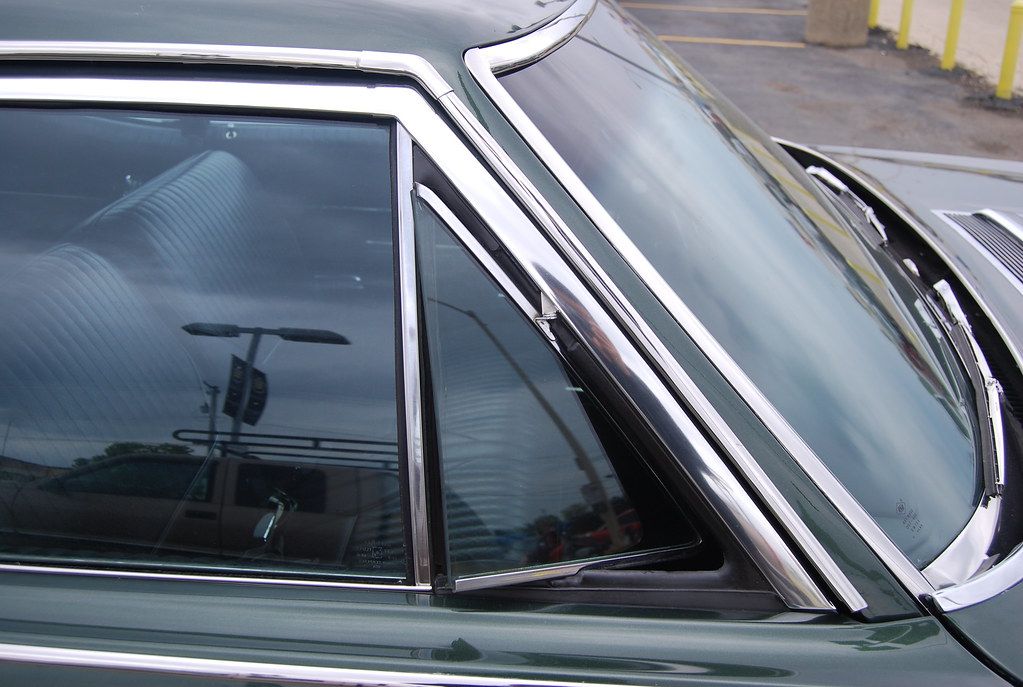
For decades, they were an undeniable fixture, a small yet mighty architectural element that offered simple, elegant cabin ventilation. The humble vent window, or quarter glass, was once as common as a steering wheel, a testament to ingenious engineering focused on driver comfort and airflow. Yet, as the automotive landscape evolved, these once-ubiquitous panes began their slow, inevitable fade from our door panels, leaving a legacy that continues to intrigue enthusiasts.
This comprehensive exploration delves into the fascinating history and varied forms of the vent window, tracing its evolution from a basic functional component to a sophisticated design element. We will uncover diverse iterations of these essential windows, examining their role in shaping interiors and how, one by one, they succumbed to progress. Prepare to journey back in time and rediscover the nuanced world of these vanished automotive features.

1. **The Classic Pivoting Front Door Vent Window**The quintessential vent window, the small, triangular glass panel at the leading edge of front doors, is perhaps the most iconic vanished automotive feature. Often called a “wing window,” it provided unparalleled control over cabin air circulation. With a simple latch, this pane rotated inward, scooping fresh air directly into the interior—a revolutionary comfort feature in the pre-air conditioning era. It was a clever design, blending form and function to epitomize early automotive ingenuity.
Beyond targeted ventilation, these pivoting windows served practical purposes. Smokers found them invaluable for ash disposal, allowing smoke to exit quickly without lowering the main window. This functionality also reduced wind resistance and cabin noise, enhancing long journeys. Its widespread adoption from the 1930s to the 1980s underscores its fundamental role in providing a crucial balance between environmental exposure and interior comfort, delivering fresh air with elegant precision.
However, the classic pivoting front door vent window ultimately met its demise. The advent of factory air conditioning rendered its primary function obsolete, while security concerns arose. Coupled with declining smoking rates and a push for cleaner, aerodynamic “ventless” styling, this beloved triangular window faded from new car designs, leaving a void modern climate control systems still sometimes struggle to perfectly fill.
Read more about: The Truck Buyer’s Almanac: 12 Pickups Poised for Major Price Drops on Dealer Lots

2. **Early “Ventipanes” on All GM Products**The year 1933 marked a significant milestone with the widespread introduction of “Ventipanes” across all General Motors products. These were innovatively installed as both front and rear vent windows, offering what GM termed “No Draft Individually Controlled Ventilation.” This system aimed to provide personalized climate control for all occupants, a true luxury in an age when cars were still largely open or semi-open vehicles.
The genius of “Ventipanes” lay in their ability to draw in fresh air without uncomfortable drafts. By carefully angling the panels, air flowed gently through the cabin, refreshing the environment without harsh wind buffeting. The 1933 Pontiac Economy Eight exemplified this, showcasing GM’s commitment to integrating this feature. The patent, filed in 1932, highlighted GM’s strategic development in advanced ventilation.
“Ventipanes” initially proved highly successful, defining GM’s approach to vehicle design and enhancing both functionality and perceived luxury. However, they eventually faced similar pressures to other vent windows from evolving safety standards, the rise of factory air conditioning, and desires for sleeker body lines. The “No Draft Individually Controlled Ventilation” slowly receded as integrated climate control became the new paradigm, making “Ventipanes” a cherished memory.
3. **Rear-Located Stationary Quarter Glass (Early Applications)**While “vent window” implies pivoting functionality, “quarter glass” encompasses broader designs, including early stationary panels located just forward of the rear-facing rear window. These non-movable windows were not strictly for venting, but critically influenced the broader evolution of vehicle glazing and the eventual disappearance of dedicated venting features. They primarily served to enhance outward visibility and contributed to the aesthetic continuity of the vehicle’s side profile..
These stationary rear quarter glass panels were integral to early closed carriage and automobile body structures, filling gaps between main windows and the rear pillar. Their presence allowed for larger overall glass areas, brightening the cabin and reducing blind spots. The fixed nature simplified mechanical complexities, enhancing body rigidity and reducing manufacturing costs, thus foreshadowing a broader shift where fixed panes would increasingly replace movable ventilation windows.
The evolution of these stationary panels indirectly contributed to the “vanishing” of dedicated vent windows. As manufacturers embraced fixed glass solutions for structural integrity, cost-effectiveness, and cleaner aesthetics, reliance on small, pivoting windows diminished. Improved forced-air ventilation and air conditioning further cemented this shift. While stationary quarter glass persists in some forms, it signifies a broader transition, marking the *spirit* of active, driver-controlled ventilation as a design philosophy that gradually vanished.

4. **C-Pillar Mounted Fixed Quarter Glass**Automotive design saw the evolution of quarter glass into specialized configurations like the fixed panel set into the C-pillar. This design marked a departure from the traditional front door vent window, serving different purposes, primarily enhancing driver and passenger visibility while contributing to structural integrity and aesthetic flow. These C-pillar windows were firmly integrated, underscoring a broader trend towards sealed, climate-controlled environments.
Positioned in the rearmost pillar, these panels allowed crucial light into the passenger compartment and provided vital visual aid for drivers, minimizing blind spots during maneuvers. This C-pillar quarter glass was distinct from the main rear window, often smaller, balancing sheet metal with panoramic views. The context clarifies it would “not be called an ‘opera window’,” emphasizing its functional, architectural purpose over decoration, integrating seamlessly with the roofline for structural rigidity.
The widespread adoption of fixed C-pillar quarter glass designs marked another evolutionary step in the disappearance of the traditional vent window. As vehicle bodies became more monocoque, fixed windows became the norm for structural reasons. Sophisticated air conditioning systems further reduced the need for small, manually operated vents. While C-pillar quarter glass endures, its prominence reflects a significant shift away from the active ventilation philosophy of earlier vent window eras.
Read more about: The Enduring Mystery Solved: What ‘442’ Truly Means on Oldsmobile’s Legendary Muscle Car
5. **AMC Pacer’s Optional Front Vent Windows**Sometimes, older features experience a brief, notable return. The AMC Pacer, a distinctive 1970s car, offers a fascinating case in the persistence of the vent window. When many manufacturers phased them out for cleaner styling, the Pacer offered optional front vent windows. This decision underscored AMC’s commitment to practical comfort, providing “increased flow-through ventilation” and capitalizing on the vent window’s core strength, especially before universal air conditioning.
The Pacer, with its wide body and expansive glass, focused on interior space and visibility. These optional vents offered tangible benefits for those seeking maximum natural airflow, allowing customizable fresh air without the full blast and noise of a main window. It was a nod to traditional utility in a design that otherwise pushed boundaries, catering to drivers and passengers who prioritized individual climate control.
However, the context notes, “Although the front venting windows ‘provide unmatched ventilation, air turbulence and leakage outweigh the benefits’.” This candid observation captures why traditional vent windows lost favor. The inherent challenges of sealing, aerodynamic efficiency, noise, drafts, and reduced fuel efficiency at higher speeds overshadowed benefits. The Pacer’s attempt proved an exception, as safety regulations and more sophisticated air conditioning sealed the feature’s fate industry-wide.
Read more about: From Showroom Shocker to Silver Screen Legend: 6 Automotive Flops That Conquered Hollywood

6. **Lincoln’s Powered Retracting Vent Windows**As the automotive industry transitioned to electric controls, luxury marques like Lincoln sought to elevate the vent window. In the late 1970s and 1980s, Lincoln vehicles featured powered vent windows that offered a blend of traditional functionality with modern convenience. These sophisticated systems allowed the small quarter glass panels to retract seamlessly into the door, much like a regular car window, before the main window. This provided effortless operation at the touch of a button.
Integrating power transformed the vent window into a luxury amenity. For drivers of these upscale Lincoln models, electrical control added refinement and ease, offering precise airflow adjustment without manual struggle. This technological leap reflected a broader trend in luxury automobiles to automate functions and enhance comfort, positioning the vent window as a premium feature. The “retracted vent window of 1979 Lincoln Continental Town Car” exemplifies this blend of luxury and innovation.
Despite this advanced engineering, even Lincoln’s powered retracting vent windows eventually vanished. Continuous improvement and ubiquity of fully integrated climate control systems made dedicated vent windows redundant. The added mechanical complexity, weight, and cost for such a niche function eventually outweighed benefits. These technologically impressive iterations, once a hallmark of luxury, faded into automotive history, leaving a legacy that foreshadowed today’s sophisticated power windows.
7. **Toyota Century’s Electrically Operated Pivot-Out Vents**Vent windows, in their more refined, power-operated forms, found a unique niche in ultra-luxury vehicles where bespoke comfort was paramount. The Toyota Century, renowned for its opulence and chauffeur-driven pedigree, exemplified this with its electrically operated pivot-out vent windows. This design pivoted outward, offering a distinct approach to airflow. Notably, dedicated electric switches were provided for both front and separate rear door vent windows, emphasizing individualized control for all occupants.
The inclusion of powered rear door vent windows in a vehicle like the Toyota Century underscored a commitment to supreme passenger comfort. For executive transport, rear passengers’ ability to independently adjust ventilation was a significant luxury. This system allowed for subtle air circulation, avoiding disruption and excessive noise, differentiating it from simply cracking a main window. The outward pivot mechanism likely aimed to direct air away from the immediate cabin, contributing to a discreet aesthetic when open.
However, even the Century’s refined, electrically operated vents succumbed to broader industry trends. As cars became sealed, optimized environments for quietness and climate control, the need for these specialized vents waned. The drive for aerodynamic efficiency, simplified manufacturing, and enhanced security ultimately led to their general disappearance. The Century’s innovative vents remain a fascinating example of how a classic concept was adapted before its industry-wide fade.
Car Model Information: 2024 Toyota 4Runner TRD Off Road
Name: Toyota Century
Manufacturer: Toyota
Production: unbulleted list
Class: unbulleted list
BodyStyle: unbulleted list
Layout: unbulleted list
Predecessor: Toyota Crown Eight
Categories: 1970s cars, 1980s cars, 1990s cars, 2000s cars, 2010s cars
Summary: The Toyota Century (Japanese: トヨタ・センチュリー, Hepburn: Toyota Senchurī) is a lineup of full-size luxury cars and limousines produced mainly for the Japanese market, serving as Toyota’s flagship car within Japan; globally the unrelated Lexus LS series is Toyota’s flagship luxury model. Production of the Century began in 1967, and the model received only minor changes until redesigns in 1997 and 2018. The Century derived its name from the 100th birthday of Sakichi Toyoda (born 14 February 1867), the founder of Toyota Industries. It is often used by the Imperial House of Japan, the Prime Minister of Japan, senior Japanese government leaders, and high-level executive businessmen. The Century is comparable in purpose to the Austin Princess/Daimler DS420, Cadillac Series 70, Mercedes-Maybach, Hongqi, Rolls-Royce Phantom, and Russian ZIS/ZIL limousines. The first-generation Century was available with only a V8 engine (the third post-war Japanese-built sedan so-equipped) at its introduction in 1967 until a full platform redesign in 1997. The second generation was only installed with a Toyota-designed and -built V12, an engine bespoke to the Century, until 2018, when the power-train reverted to a V8 with the addition of Toyota’s hybrid technology. While the Century is a premium, full-size luxury sedan, it is not available at Japanese Lexus dealerships; it can only be purchased at specifically identified Toyota Store locations. The Century does not feature Toyota’s typical oval logo on any of its badges; instead, it uses a phoenix logo unique to the Century. The gold phoenix logo is called the Hō’ō or Fushichō from Sinospheric mythology, representing the Imperial House of Japan, and the image can be found throughout Asia, such as the Kinkaku-ji in Kyoto. The exterior styling of the Century has, with some modifications, remained unchanged since its introduction, primarily due to its perception as denoting conservative success. Its appearance is iconic in Asian countries and is usually painted black. The closest Japanese competitor was the Nissan President, with a similar status reputation although, during the 1960s and 1970s, the high market positioning was also shared with the Mitsubishi Debonair. In the 1970s, two other Japanese competitors introduced large sedans — the Isuzu Statesman de Ville and the Mazda Roadpacer (both derived from General Motors-Australia products) — which were short-lived. The Century nameplate introduced the SUV body style in 2023.
Get more information about: Toyota Century
Buying a high-performing used car >>>
Brand: Toyota Model: Century
Price: $39,861 Mileage: 40,307 mi.

8. **Venting Quarter Glass in Minivans: The C-D Pillar Revelation**As vehicle designs expanded to accommodate larger passenger capacities, especially in the burgeoning minivan segment, the concept of the vent window found new, specialized applications. A notable evolution was the introduction of venting quarter glass positioned between the C and D-pillars in models like the ubiquitous Chrysler Town and Country. These power-operated panels represented a late-stage adaptation of the vent window, aiming to provide individualized comfort in a distinctly family-oriented vehicle.
This strategic placement addressed a crucial need for rear passenger ventilation, particularly in the multi-row configurations of minivans. Unlike the small triangular vents of yesteryear, these larger, often rectangular quarter windows were designed for subtle, controlled airflow, enhancing the interior environment without compromising the structural integrity or expansive glass areas characteristic of these vehicles. The power operation further underscored a shift towards convenience and luxury, enabling occupants to effortlessly manage their immediate surroundings.
The adoption of such advanced venting glass in minivans highlighted a persistent demand for natural air circulation, even as climate control systems became more sophisticated. However, their ultimate decline paralleled the general trend away from dedicated vents. As integrated climate systems became more efficient and universally standard across all rows, the added complexity and cost of separate power-operated quarter glass became less justifiable, contributing to their gradual phase-out in favor of simpler, fixed window designs.
Car Model Information: 2023 Honda Civic EX
Name: Chrysler Town & Country
Manufacturer: Chrysler Corporation
Production: 1989–2016
ModelYears: 1990–2016
Class: Minivan
Predecessor: Chrysler Town & Country (1941–1988)
Successor: Chrysler Pacifica (minivan)
Categories: 1980s cars, 1990s cars, 2000s cars, 2010s cars, All-wheel-drive vehicles
Summary: The Chrysler Town & Country is a minivan manufactured and marketed by Chrysler starting from the 1990 until the 2016 model year. It was the third Chrysler minivan model introduced in North America. The Town & Country adopted its nameplate from the flagship Chrysler station wagon line, adopting its exterior woodgrain trim as a design feature for several generations.
Marketed as the flagship of the Chrysler minivan line, five generations of the Town & Country were slotted above the extended-wheelbase Dodge Grand Caravan and Plymouth Grand Voyager. For 2017, Chrysler retired the nameplate, with sixth-generation Chrysler-division minivans becoming the Chrysler Pacifica. After the 2016 model year, Chrysler marked the sale of its 12 millionth minivan (under all three nameplates). Produced almost continuously for 75 years (except during World War II and 1989), the Town & Country nameplate is the longest-produced Chrysler; its longevity is second only to the Chevrolet Suburban in automotive history.
Chrysler assembled the first three generations of the model line in its Saint Louis Assembly facility (Fenton, Missouri). The fourth and fifth-generation Town & Country were produced by Chrysler Canada by Windsor Assembly (Windsor, Ontario).
Get more information about: Chrysler Town & Country (minivan)
Buying a high-performing used car >>>
Brand: Chrysler Model: Town and Country
Price: $23,541 Mileage: 56,979 mi.

9. **Fixed Quarter Glass in Rear Doors: Responding to Wheel Housings**The evolution of automotive architecture, particularly the space constraints imposed by rear wheel housings, led to another specialized form of quarter glass. Many modern vehicles feature non-movable quarter panels mounted directly within the rear door itself, notably examples like the Buick Encore, Chevrolet Lumina APV, Toyota Prius, Opel Astra J, Mitsubishi Endeavor, Fiat Grande Punto, Suzuki SX4 sedan, and the 8th-generation Honda Civic sedan. These designs cleverly integrate a fixed glass section forward of the main roll-down window, necessitated by the door’s inability to fully retract a single, larger pane.
This specific configuration is a testament to the intricate balance between design aesthetics, structural requirements, and practical considerations. The cut-out in the rear doors, essential to clear the wheel housings, physically prevents the entire side glass from sliding down. Consequently, a fixed portion is introduced, separated from the main window by a slim, opaque vertical bar. While not offering active ventilation, these fixed panels are vital for maintaining outward visibility and contributing to the vehicle’s overall side profile and passenger light entry.
The necessity of this design showcases how fundamental vehicle engineering principles influenced the demise of active ventilation. As rear passenger comfort became more critical, alongside the demand for sleeker door designs that seamlessly integrated with the rear fenders, the practical solution often involved a fixed pane. This decision eliminated the mechanical complexity of a movable small window, replacing it with a simpler, more robust glass section that still served crucial aesthetic and visibility functions without the drawbacks of leakage or wind noise associated with older vent designs.
The prevalence of this fixed rear door quarter glass design underscores a fundamental shift in automotive engineering: prioritizing structural integrity, cost-effective manufacturing, and cleaner body lines over the added complexity of movable vents. Their permanence signifies a reliance on sophisticated HVAC systems for ventilation, marking another step in the comprehensive disappearance of manually operated or even powered, dedicated vent windows. These panels, while fixed, continue to serve as essential elements in modern car design, albeit in a non-venting capacity.
10. **Dual Fixed Quarter Windows: Enhancing Driver Visibility**In the relentless pursuit of enhanced driver visibility and improved cabin ambiance, some manufacturers ventured into designs incorporating not one, but two distinct fixed quarter windows. This innovative approach, exemplified by models like the Volvo 940, featured one quarter window as an integral part of the door structure, complemented by a second panel thoughtfully mounted within the roof pillar. This dual arrangement served a multifaceted purpose, primarily aimed at expanding the driver’s peripheral vision and illuminating the interior more effectively.
The strategic placement of these twin fixed panels was a direct response to increasing safety standards and consumer demand for better situational awareness. By breaking up potential blind spots created by thick pillars and larger body structures, these additional glass areas offered crucial visual aid, especially during maneuvers like lane changes or parking. Furthermore, the increased influx of natural light contributed to a more open and less claustrophobic cabin environment, a subtle but significant factor in overall driving comfort.
While these dual quarter windows unequivocally improved visibility—a function vital for safety—they were, by design, non-opening. Their fixed nature emphasized the industry’s pivot towards sealed, aerodynamically optimized cabins, where active ventilation was managed exclusively by advanced climate control systems. This evolution further cemented the idea that dedicated, movable vent windows were becoming an anachronism, replaced by integrated, static glass solutions that prioritized structural rigidity and passive safety over manual airflow adjustment.
11. **The Fully Removable Rear Quarter Window: A Parade Limousine’s Unique Flourish**Among the most specialized and intriguing forms of quarter glass to have vanished is the fully removable rear quarter window, a feature prominently showcased on the Mercedes-Benz 300d “parade limousine.” This exceptionally rare design transcended mere ventilation, serving a ceremonial and functional purpose that set it apart from conventional automotive glazing. The ability to completely detach this final triangular pane from the vehicle’s rear created an unbroken expanse of openness, a truly bespoke touch for an elite class of vehicle.
In its unique application, the removable quarter window was not about scooping air but about visibility for a different kind of audience. For dignitaries and VIPs, seated in the back of these parade limousines, its removal allowed crowds an unobstructed view, transforming the vehicle into a rolling stage. This bespoke engineering solution underscored the lengths to which luxury manufacturers would go to meet highly specific client needs, blending the practical with the performative in an elegant, if temporary, alteration of the car’s silhouette.
However, the very niche nature of this design, coupled with its inherent complexity and the shift towards fully enclosed, climate-controlled environments for high-profile transport, meant that such removable panels remained an anomaly. The increased emphasis on security, structural integrity, and standardized manufacturing processes ultimately rendered such specialized, detachable windows impractical for widespread adoption. The Mercedes-Benz 300d’s removable pane thus stands as a fascinating, albeit rare, testament to the extreme versatility—and eventual obsolescence—of specialized quarter glass concepts.
12. **A-Pillar Mounted Fixed Quarter Glass: The Forward Visibility Solution**As automotive designs continued to evolve, another distinct application of fixed quarter glass emerged, strategically placed in the A-pillar area, ahead of the front door opening. This particular configuration can be observed in a diverse range of vehicles, from the Buick Encore and Toyota Prius to the Opel Astra J and 8th-generation Honda Civic sedan. Unlike traditional front door vent windows, these panels are non-movable and serve primarily to enhance forward and side visibility, helping drivers navigate complex urban environments and tight turns.
The integration of fixed quarter glass into the A-pillar is a direct response to modern vehicle designs that often feature thicker A-pillars for improved structural crashworthiness and roof strength. While these robust pillars enhance safety, they can inadvertently create blind spots. By incorporating a small, stationary glass panel, designers effectively reduce the visual obstruction, offering drivers an extended field of view and significantly improving safety during maneuvers such as pulling out of intersections or tight parking spots.
This design choice highlights a broader industry priority: maximizing safety through enhanced visibility, even if it means foregoing traditional ventilation methods. The fixed nature of these panels contributes to the vehicle’s overall rigidity and aerodynamic efficiency, minimizing wind noise and optimizing the climate-controlled cabin experience. It’s a clever engineering solution that mitigates the necessary trade-offs introduced by modern safety structures, ensuring that functionality is maintained without reintroducing the complexities of movable glass in this critical area.
This type of quarter glass, while essential for modern visibility requirements, further illustrates the complete departure from the active ventilation function of historical vent windows. Its fixed nature signifies the industry’s confidence in advanced climate control systems to manage cabin air quality and temperature. The A-pillar mounted fixed quarter glass thus represents an advanced evolution of the quarter panel concept, where its role has shifted entirely from ventilation to visual safety and aesthetic integration, marking another chapter in the vent window’s long, winding path to disappearance.

13. **Urethane-Bonded Fixed Quarter Windows: The Modern Standard of Integration**The ultimate disappearance of the traditional vent window and the widespread adoption of fixed quarter glass can be largely attributed to advancements in material science and manufacturing techniques. Modern non-opening, fixed quarter windows are no longer simply “installed”; they are meticulously bonded to the vehicle’s body with urethane, much like a windshield. This method of integration represents a pinnacle of structural rigidity, aerodynamic efficiency, and refined aesthetics, providing a stark contrast to the often leaky and complex mechanisms of their pivoting predecessors.
This bonding process creates a virtually seamless integration of the glass with the body, contributing significantly to the vehicle’s overall structural integrity and torsional rigidity. The resulting sealed cabin not only enhances noise isolation but also provides a more controlled environment for advanced climate control systems to operate efficiently. This level of sealing is paramount for the effectiveness of modern HVAC units, ensuring consistent temperature and air quality throughout the vehicle.
From an aesthetic standpoint, these bonded windows allow for cleaner, more contemporary body lines, free from the visual interruptions and potential aerodynamic drag associated with movable vent panels. The smooth, uninterrupted surfaces contribute to a modern, sophisticated look that aligns with current automotive design philosophies, which often prioritize sleekness and minimalist forms over visible mechanical complexity. This stylistic preference, combined with the technical benefits, sealed the fate of the movable vent.
The shift to urethane-bonded fixed quarter windows is a clear culmination of the trends that led to the vent window’s demise: the prioritization of structural strength, aerodynamic performance, enhanced cabin quietness, and the unchallenged dominance of air conditioning. These modern, non-opening panels signify the final evolution in the journey of the quarter glass, from a manually operated ventilation device to an integral, fixed component of the vehicle’s sealed, climate-controlled, and aesthetically optimized shell. They are the silent, steadfast descendants of a once-breezy automotive icon.
As we conclude our journey through the fascinating history of the vent window, it becomes clear that its disappearance wasn’t a sudden event, but a gradual evolution driven by relentless innovation and changing consumer demands. From the simple pivot of the classic wing window to the specialized fixed panels of today, each iteration tells a story of automotive progress. While the breezy triangle may be gone, its legacy lives on in every meticulously sealed, climate-controlled cabin, reminding us of a time when a twist of glass brought a breath of fresh air, and a touch of ingenious simplicity, to our drives. The vent window, in all its varied forms, stands as a testament to the ever-changing landscape of automotive design, where even the most beloved features can yield to the march of technology and style.



